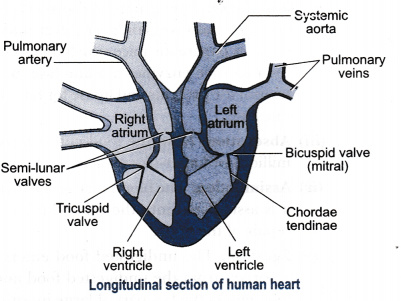Describe internal structure of a human heart.
Answer:

The two auricles or atria are thin-walled and are separated from each other by a thin inter-atrial septum. The right atrium receives venous (deoxygenated blood having very little 02) from the entire body through a superior and inferior vena cava. The left smaller atrium receives oxygenated blood from the lungs through four pulmonary veins.
The two auricles (atria) are separated from the ventricles by two apertures guarded by membranous valves. The valve separating right atrium from right ventricle is called right atrio-ventricular valve or tricuspid valve made up of three flaps. The valve separating left atrium from left ventricle is called left atrio-ventricular valve or mitral valve, formed of two flaps. These valves are attached with fine cords with the papillary muscles of the ventricular wall. These valves only allow blood flow from auricles into ventricles and not in opposite direction.
Both the ventricles are separated from each other by a thick inter-ventricular septum. The wall of left ventricle is much thicker than that of right ventricle. The left ventricle pushes blood into aorta which supplies blood to entire body. The opening of aorta is also guarded by a valve formed of 3 semilunar flaps. The right ventricle pumps venous blood into lungs by a pulmonary aorta. Its opening is also guarded by a valve, having 3 semilunar flaps. These valves allow the flow of blood from ventricles into the aorta and not back. Heart is formed of cardiac muscle fibres, which rhythmically contract the heart without feeling fatigue.